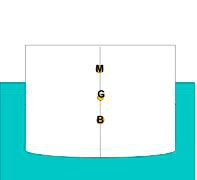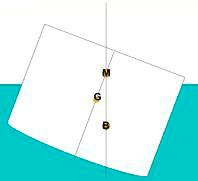By Vincent Pica, Commodore, First District, Southern Region (D1SR), United States Coast Guard Auxiliary
Certainly, tragedies abound that point to the urgent need for more understanding by boat captains about the forces of capsizing. There is a tremendous amount of data on “righting moments,” centers of buoyancy and gravity, thanks to the U.S. Navy and the U.S. Coast Guard, amongst many institutions that literally live and die by these metrics.
Some Background
To understand the forces of a capsizing, and how those forces change when you load the boat, let’s get some terms under our belt. Most of us understand “center of gravity” (G) instinctually. But what is the center of buoyancy? The center of buoyancy (B) is the center of the volume of water which the hull displaces. When a ship is stable, the center of buoyancy is vertically in-line with the center of gravity of the ship. So, as long as the center of gravity (G), pushing the boat down, is above the center of buoyancy (B), pushing the boat up, we’re good. How good? That is a very good question and as with many good questions, it requires more information to answer properly. Take a look at diagram A.
Diagram A

What is that “M” sitting up there above our trusty center of “G”ravity and the center of “B”uoyancy? That is something very important called the “M”etacenter. The metacenter remains directly above the center of buoyancy regardless of the heeling (tilting caused by external factors like wind or waves) or listing (tilting caused by internal factors such as poorly stowed cargo or on-boarding of water by wind or waves) of a boat.
Diagram B

Take a look at Diagram B. If you are starting to worry about the distance between “G” and “M,” called the “Metacentric height” (or “GM” in naval architecture parlance), you’re catching on quickly. The math gets pretty complicated from here, but suffice it to say that the ability of the boat to right herself, i.e. her “righting arm” or “righting moment,” has a lot to do with GM. The larger the GM acting as a lever, the better. Sailboats are designed to operate with a higher degree of heel (greater GM) than motorboats, but the principles are exactly the same.
From This to Wave Height?
Yes. You can infer that your motorboat’s center of gravity and center of buoyancy can’t be too far apart when the entire distance from the keel to the floorboards is probably something like 2 or 3 feet. Think of her draft. It isn’t a big number, even for a 40-footer. No reason to panic, but you now realize that M, G and B can’t be that far apart – which means that GM just can’t be that great either. And GM is a surrogate for the righting ability of your boat.
“But wait,” you say. “I’ve been out in some pretty steep seas, and I think the boat handled it well.” Yes, because studies conducted by the Society of Naval Architects and Marine Engineers (SNAME) determined that three things must exist for a capsizing to occur:
- The boat is broadside to the wave. Yes, a boat can be pitchpoled (tossed end-over-end), but the size of the wave needed to do that greatly exceeds the size of the smaller wave needed to knock a boat down when broadside to a wave.
- The boat is struck by a breaking wave.
- Wave height must exceed a certain percentage of the boat’s length.
At this point, the wave contains enough energy to overcome a boat’s righting moment.
So, what is that “certain percentage?” At only 30% of your boat’s length, (about 6 feet from tough to crest for a 20-foot boat), things enter directly into the realm of high danger. At 60%, it is nearly certain that one wave will catch you and then you, the crew and the boat may well come to grief.
One Last Thought…
There’s an old saying, at least in the Coast Guard, that every rule is written in blood and as a consequence we often appear to be “piling on” when a tragedy ensues. So, lest more tragedy befalls us as a maritime community, remember: as you change the weight of the boat, you lower the center of gravity. This makes the boat “more tender,” i.e. it reduces the righting arm – which makes the boat easier to capsize. As you add people and cargo/gear to a boat, keep thinking about how the righting arm is getting shorter and shorter…
If you are interested in being part of the USCG Forces, email me at JoinUSCGAux@aol.com or go direct to the D1SR Human Resources department, who are in charge of new members matters, at
d1south.org/StaffPages/DSO-HR.php and we will help you “get in this thing.”
The Acting Commander for US Coast Guard Sector Long Island Sound is Commander Kevin Reed. CDR Reed is responsible for all active-duty, reservist and auxiliary Coast Guard personnel within the Sector. As a Commodore of the US Coast Guard Auxiliary First District, Southern Region, Vin Pica works closely with CDR Reed and his staff to promote boating safety in the waters between Connecticut, Long Island and 200 nautical miles offshore. Sector Long Island Sound Command Center can be reached 24 hours a day at 203-468-4401.



